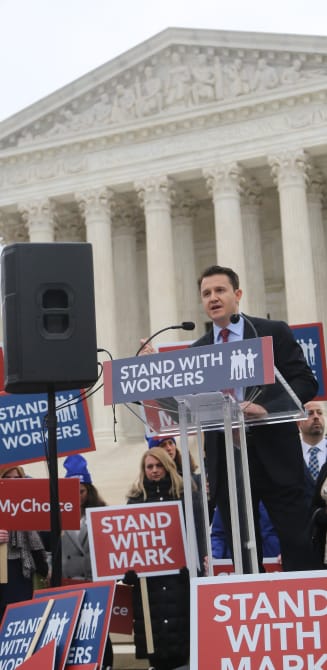The rising cost of healthcare coverage is an increasing problem for small businesses, their employees, and self-employed workers in the gig economy. Employers are often faced with difficult choices of whether to offer health insurance benefits, decrease staff, convert positions to part-time, or raise prices. Individuals face rising premiums, increased cost-sharing requirements, and decreased value for the dollars that they spend on healthcare insurance. Legislation currently advancing through Congress holds the promise of a remedy, and Goldwater is fully on board.
The Problem
Rising costs threaten the availability of health insurance benefits for small business employees and gig workers. Data from 2022 indicates that 53 percent of the 1,209 small businesses surveyed had considered ending health insurance coverage for employees. The negative impact of rising health insurance benefits also leads small businesses to cancel raises, reduce hiring, increase the price for their goods and services, and convert positions from full to part-time.
For the years immediately prior (2002-2021), the impact of rising costs was documented in data showing that the percentage of small businesses (defined as businesses with fewer than 50 employees) offering health insurance decreased by 28 percent. For those employees who were fortunate to have coverage available, premium costs rose 118 percent for individual coverage and 140 percent for family coverage over the same 19-year period.
According to the 2024 edition of a quadrennial survey conducted by the National Federation of Independent Business (NFIB), affordability was the central obstacle for small businesses that wished to provide health insurance coverage for their employees. The survey report noted that health insurance costs “continue(s) to be the number one small business problem, a position it has held since 1986.”
Distinct Advantages For Large Business
For several reasons, large businesses are able to offer health insurance to their employees at price-per-benefit costs far below those available in the small group or individual markets. The major reason for the disparity in cost per benefit is scale. Large companies are simply in a better position to negotiate with health-insurance providers because they offer a larger pool of insureds over whom the risk of expensive healthcare claims can be spread.
Large companies also have other advantages. Large-group plans are subject to lower health insurance loads, i.e., the portion of paid premiums above anticipated claims expenses. The large-group plans also benefit from regulations that restrict the percentage of paid premiums that may be used for profit and administration. Lastly, large-group plans are not subject to user-fee expense. User fees of 1.2 to 1.5 percent are charged to insurers selling in the individual market on the Patient Protection and Affordable Care Act (ACA) exchanges.
Combined, these disparities make it possible for large companies to negotiate lower prices for health insurance benefits for their employees. These cost savings contribute significantly to their popularity. Large group health plans provide healthcare coverage for 78 million Americans, exceeding the number of Americans covered by Medicare.
Leveling The Market For Small Business & The Gig Economy
Association Health Plans (AHPs) offer a remedy, providing needed relief to level the marketplace for health insurance coverage for small businesses. AHPs make it more economically feasible for small-business employers to offer coverage by making health insurance coverage more affordable and increasing the value of each dollar invested for both individual small businesses and their employees. AHPs also hold potential for making health insurance more accessible for over 50 million Americans who work in the gig economy.
The Legal Construct
An AHP is a legal entity whereby a group of small businesses or self-employed individuals can legally cooperate to sponsor a group health plan. Like group purchasing organizations, credit unions, and other similar cooperative arrangements, the organized entity’s strategy is to pool its combined demand for products and services to secure lower prices.
The Employee Retirement Income Security Act of 1974 (ERISA) codified AHPs. But, importantly, the regulation of AHPs has continuously evolved as changes and modifications were deemed appropriate since it was enacted.
For example, the Health Insurance Portability and Accountability Act of 1996 (HIPAA) imposed additional obligations on AHPs, prohibiting large group AHPs from denying eligibility based on health status, pre-existing medical conditions, past claims history, genetic information, or disability. In 2010, the ACA mandated that AHPs offering major medical coverage cover certain preventive health services without cost sharing. The ACA also prohibited AHPs from imposing annual or lifetime limits for covered benefits.
Proof of Concept
The Department of Labor finalized a new regulation for AHPs in mid-2018 that made it easier for small employers to cooperatively offer health insurance. The regulation had a progressive implementation schedule, starting in September 2018 and continuing through April 2019. The aim of the new rule was to broaden the definition of “employer” under ERISA, thus making it easier for groups of small businesses to form an AHP.
Unfortunately, in July 2018, eleven states and the District of Columbia filed a suit challenging the rule on AHPs, arguing that it violated the Administrative Procedure Act and exceeded the Department of Labor’s authority. In March 2019, the U.S. District Court for the District of Columbia largely invalidated the rule and found that its provisions regarding the definition of an association were inconsistent with the intent of ERISA and the ACA.
However, in the brief six-month period between September 2018 through March 2019, AHP premium savings reached double digits. Importantly, those savings materialized without any evidence of market segmentation or other adverse effects on the individual and small group market that were predicted by critics. Further, it should be noted that even in the absence of enhanced availability of AHPs, the small-group health-insurance market has continued to decline.
Potential Durable Remedy Before Congress: HR 2528
Because administrative action failed to level the marketplace for health insurance, a more durable remedy is required via legislation that mandates changes to ERISA. In pursuit of that goal, Representative Tim Wahlberg (R-MI), Chairman of the House Committee on Education and Workforce, introduced HR 2528, the Association Health Plans Act.
Effectively, the legislation would broaden the definition of “employer” such that a group or association of employers, regardless of industry, trade, or profession can establish and maintain an employee welfare benefit plan that provides coverage to at least 51 employees.
After HR 2528 was introduced, a hearing by the Education and Workforce subcommittee on Health, Employment, Labor and Pensions was held on April 2, 2025. Testimony in support of the legislation was provided by representatives of the National Association of REALTORS and the National Federation of Independent Business. Subsequently, on June 25, 2025, the full committee considered the legislation in mark-up proceedings and reported the bill out of committee favorably. Currently, there is a bipartisan group of 25 co-sponsors of the legislation.
Congress Should Act
The full Congress should now act to bring fairness to the health insurance marketplace. Small business employees and those in the gig economy deserve the same cost advantages and value per dollar invested in their health insurance as is available to employees of large businesses.









